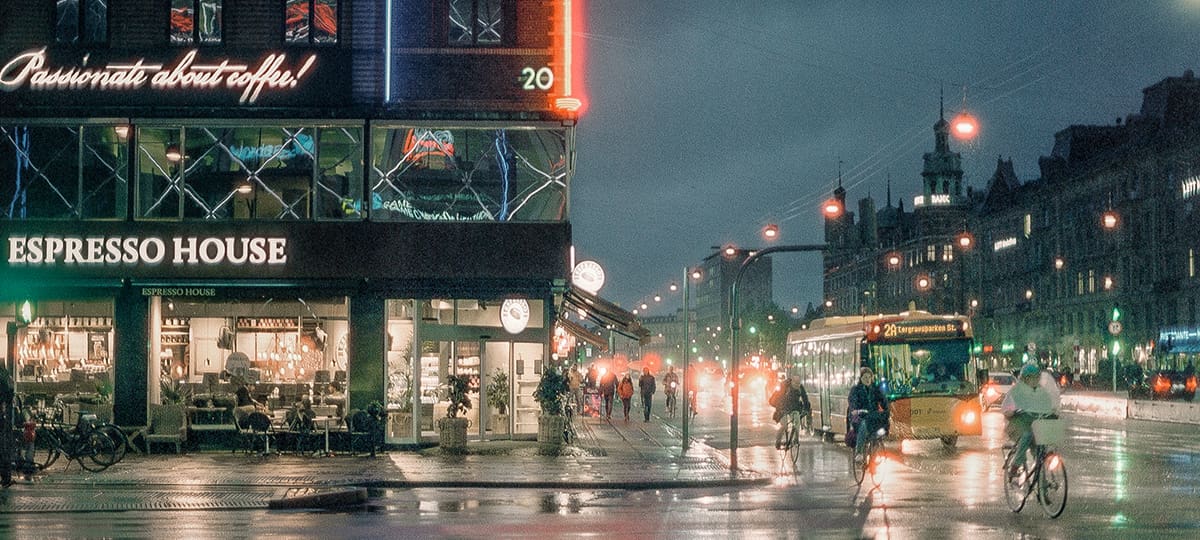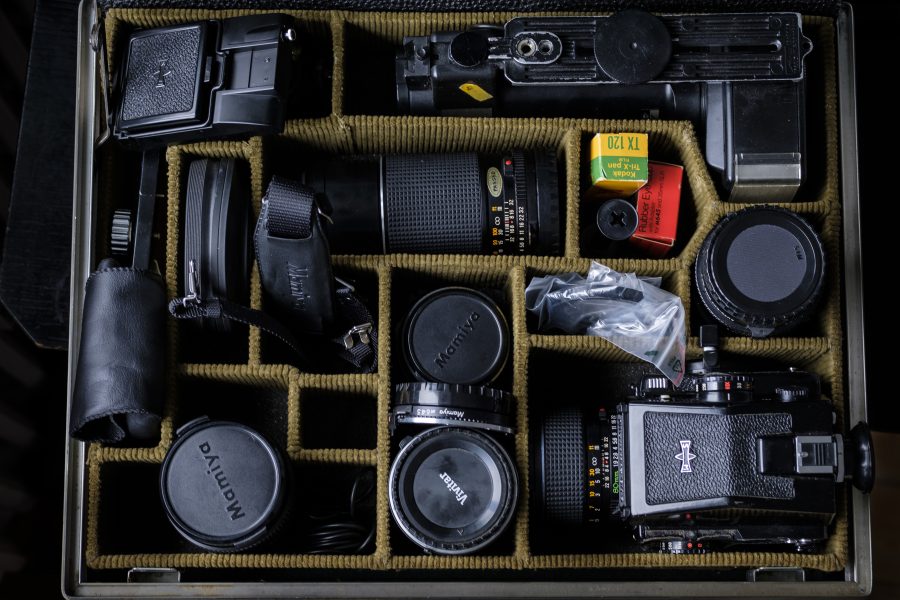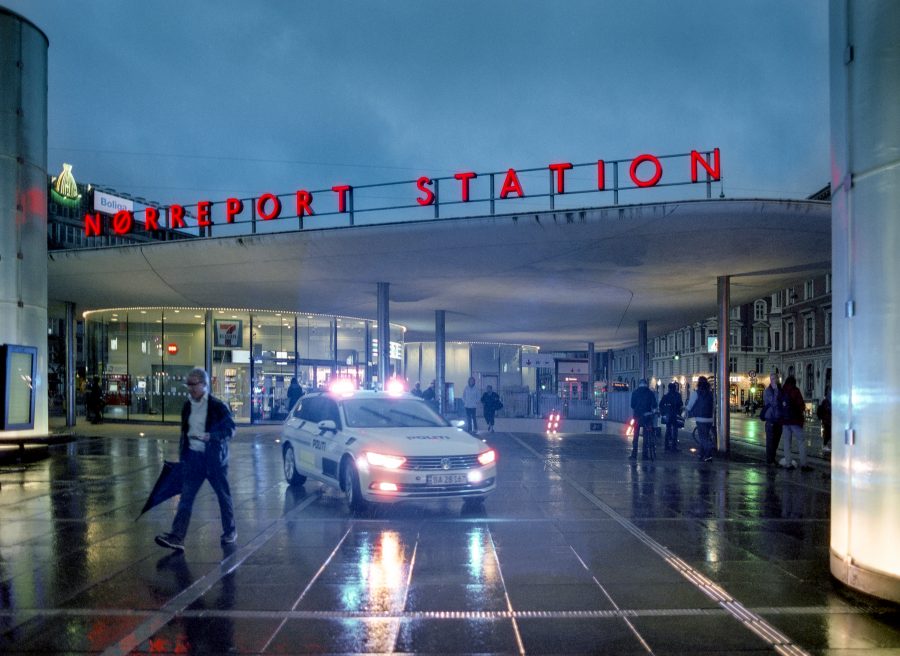When I started out with photography a few years ago film photography was pretty much dead, but recently it’s been coming back big time. What got me interested was seeing night photos shot with Cinestill, a brand new film that gives a very cinematic look, something I just couldn’t reproduce in post processing. So I decided to give it a try, and I wrote this blog post to document everything I had to go through. I spend a lot of money buying used film gear and reselling it, hopefully this will help you avoid the mistakes I made.
Mamiya M645 – A good all around medium format camera
It all started out when I won an auction for a suitcase full of Mamiya 645 stuff. To people that don’t know, that is an old medium format camera system with film in the size of 6×4.5cm (pretty large), something that professionals used back in the 70s to 90s. The suitcase contained a Mamiya M645 camera, a few lenses, a flash, teleconverters, macro rings, filters and more.
What attracted me most to the camera was the Hasselblad look and modular system, and I heard that this was a cheaper but still very good alternative to the expensive Hasselblad cameras and Zeiss lenses.
Initially it was a bit of a challenge to use. The waist level viewfinder (you look into the camera from the top) looks cool but is a pain to use: your moments are reversed meaning you have to move the camera in the opsosite directions when framing, never got used to it. Also no light meter when using the waist level viewfinder, so you have to use somekind of external light meter. Nailing focus is also hard but it has a magnifying glass you can fold out that helps, but still not as good as a good prism viewfinder. Expect to have problems with these waist level viewfinders.
The Mamiya 645 lenses are great. I have tried a lot of vintage lenses (35mm, medium format), and so far I only really got impressed by two vintage lens companies: old Zeiss lenses and Mamiya 645 lenses. I love the rendition and colors. Also ended up adopting the lenses on my digital Fuji X cameras with an adapter, and uses the lenses with a Rhinocam adapter (check out my review of it here).
These are the lenses I ended up getting, all nice lenses.
- Mamiya Sekor C 45mm f2.8 N – a wide angle lens.
- Mamiya Sekor C 80mm f2.8 – The standart length, 50mm equivalent. Great lens, small, light and very cheap. Amazing value for money. Check out this 134 megapixel photo I took with this lens, my Fuji X-T20 and a Rhinocam adapter. Get this, don’t get the f1.9 version.
- Mamiya Sekor C 80mm f1.9 – Ok lens, a bit more soft than the f2.8 version and has less contrast, also bigger, heavier and more expensive. Analog film is already soft and unsharp, shooting a 80mm at f1.9 will give you more soft images than you want.
- Mamiya Sekor Macro C 80mm f4 – Macro lens that people also claim is the sharpest lens, maybe I got a bad version, my copy was not sharper than the f2.8 version.
- Mamiya Sekor C 110mm f2.8
- Mamiya Sekor C 210mm f4 – great and sharp lens.
- Mamiya Sekor C 300mm f5.6
Update: Also check out my big medium format lens test here.
Pros:
- Awesome lenses, sharp and good price. Even worth buying the lenses just to put on your digital camera.
- Everything is high quality stuff.
- Camera looks cool!
Cons:
- Too old school: The Mamiya M645 and other 70s/80s cameras are very mechanical cameras, not much electronics. Can be good since you can repair it easier than electronic film cameras. But you will end up missing all the electronic options. A good light meter, auto rewind, auto focus even, better viewfinder would be nice.
- Mamiya is good, but it’s not the best out there. Some of the lenses are a big softer compared to Zeiss glass. I recommend checking out Hasselblad if you got the money for it.
Cinestill 800 film – A cool nighttime film stock
This new film was original why I got into shooting film. I saw Big Head Taco using it and loved the cinematic look it gave, perfect for evening street photography. The look has these blue-green tones, with red rings around light sauces.
The film is tungsten light, meaning it’s color balanced for 3200k, where most films are daylight balanced at 5600k. Scanning the film yourself and adjusting the color balance it doesn’t matter, but if you get prints they will look blue unless you shoot in yellow tungsten light or use a yellow filter.
At first I was hyped but getting my scans back I was disappointed. Iso 800 is a lot more grainy than on digital, maybe like iso 6400, iso 12800 or more. Cinestill does have a cinematic look, but I had a hard time accepting that analog film doesn’t look that clean, and is mostly useable to view on the web or social media in smaller sized images.
Pros:
- A unique look, good for urban-neon-hipster-night-photography.
Cons:
- A lot of grain / noise.
Light meter options
If you go for older film cameras you will probably have to meter your light manually. Even if the camera has a build in light meter, it can give unstable results or be broken (they often are, ask before you buy).
Your options:
- External light meter – good ones are a bit expensive, but this is a your best option.
- Light meter apps for your smartphone – I tried a lot of them free and paid ones. I like the idea, since you always have your phone on you. But at least on my cheap android phone they didn’t work at all.
- Use your digital camera as light meter. It works but it’s a bit of a pain in the ass to always hold two cameras.
- Learn to guess your exposure settings. I never learned to guess all light settings, but going out shooting street in the evening you can easily learn to guess those settings (light will problably only vary 2-3 stops max and easy to guess).
- My favorite: Get a more modern film camera, one from the 90’s or early 00’s with a working light meter. A lot of more modern film cameras will also have the option to do spot metering, which means you can meter different areas of a scene and make the decision based on that.
- Update: I recommend check out Kyle McDougall’s video on how he do light metering here.
You don’t hear film nerds complaining about this, but having to deal with these problems are a big disadvantage compared to digital cameras, just be aware.
Pentax 6×7 – The king of medium format cameras
The bigger the film, the finer film grain, the more details. A popular choice is the king of larger medium format cameras, the Pentax 6×7. Compared to the Mamiya 645’s 6×4,5cm film, the Pentax 6×7 has 6x7cm film.
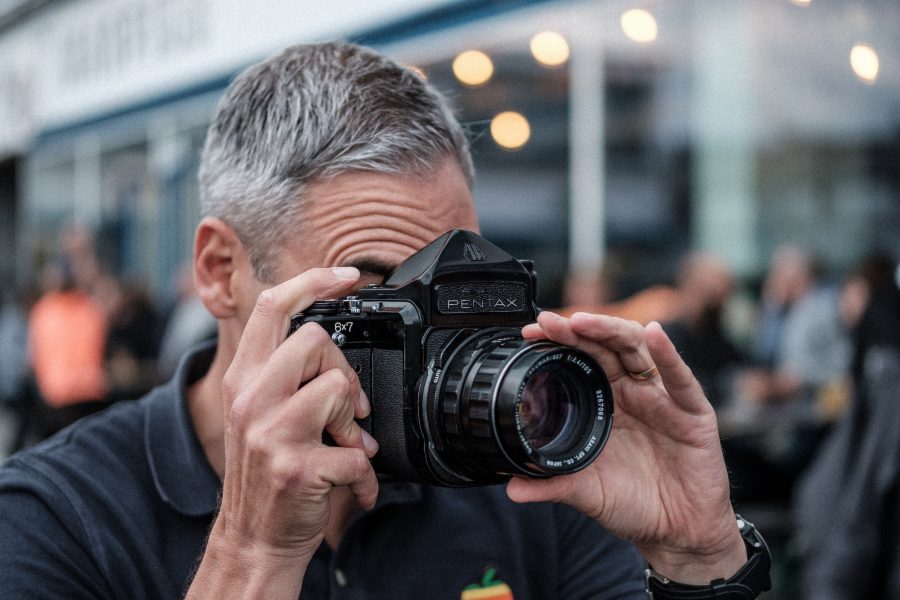
My friend holding the giant Pentax 6×7 + 105mm f2.4 lens. Photo is not shot on film but on Fujifilm X-T20 + XF 50mm f2.0
The camera looks like a monster, it’s big and ugly and when you bring it somewhere public you will get attention, people will laugh of you and when you take photo the shutter sound will make people wonder “what is that sound?”.
It’s very hyped in the film communities, and a lot of very talented photographers use it. It wasn’t the camera for me though. It’s very big, too big. Not only are the camera big but also the lenses. And the design is so strange, that big slr camera design. It also felt very old and clunky, not something that inspired me. There is a version II, maybe something to look for, but that one is even more expensive.
Here are the lenses I ended up with:
- SMC Pentax 6X7 55mm f4 – A wide angle lens, known for sharpness and good for landscape’ish photography.
- SMC Takumar 6X7 105mm f2.4 – Standart lens. The fastest lens for the camera. If you get this camera, you probably want this lens.
Pros:
- Big 6×7 size film and finer grain.
- Will get you attention walking around with it, if you want that or not.
Cons:
- Bigger film (or sensor) comes with a prices, the camera/lenses becomes bigger, lenses become slower (lower aperture), longer lenses means you have to either use tripod or shoot at higher shutter speeds (to avoid lens blur), and less things are in focus on bigger film/sensor. Taking those things into account, the 6×7 film size is too big.
- A bit controversial but I think the lenses are a bit overrated. Testing the lenses I found Mamiyas lenses better than Pentax’s, sharper and less chromatic aberration. If you get Hasselblad with Zeiss class you can probably get even better sharpness. Check out my big medium format lens test.
- It’s a big and heavy + you need a tripod: The Mamiya with it’s shorter and faster lenses I can shoot at low light, but the Pentax need a tripod unless it’s bright daylight.
- Is the 6×7 that much more worth it than 6×4.5? To me the difference was not something I noticed.
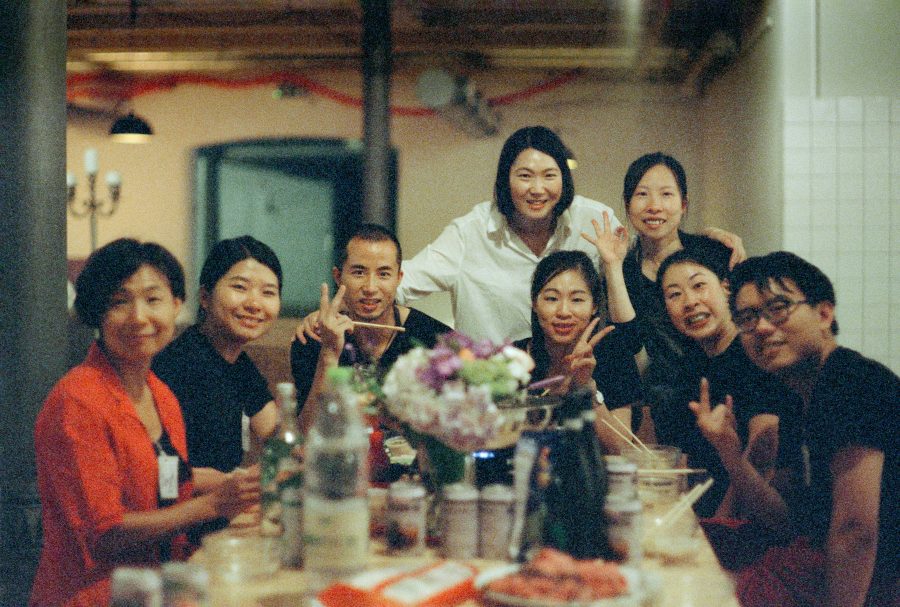
Shot with Minolta X-300 + 58mm f1.4 lens + Cinestill 800 film, a good budget 35mm camera.
Minolta X-300 – A cheap 35mm film camera
I also decided to try out 35mm cameras (what most people had back in the day). Advantages are smaller cameras and lenses, faster lenses, and more shoots on one film roll. The disadvantages are the smaller film size and bigger grain.
You can get them very cheap these days since since most people had a 35mm slr camera before digtal. I pick a few up a my local 2nd hand stores. On of them was the Minolta X-300 camera with a Minolta MC Rokkor-PF 58 mm f1.4 (paid 20 euro~ for it). A great small camera and a great lens, nothing special but also not something bad.
For shooting portraits and people photos, 35mm are great. For detailed landscape/cityscape I do miss the larger film size. The gains are bigger and there is less details.
Pros:
– Cheap, you can go to your local 2nd hand store and find lots of cheap options.
– Faster lenses and small size, good for people photos, good for street photography.
Cons:
– Lower image quality, not good for cityscape/landscapes.
Pentax 645N – A modern automatic medium format camera
Being burned out on the old machanical analog film cameras and having too many photos under or overexposed (from the bad or lack of light meter) or not in focus, I decided to try a more modern medium format film camera.
It was auto focus, it was a great view finder, auto film rewinder, it got all the things you need from a modern camera. The viewfinder was big and bright and it made it a lot easier.
First impression was very good, it was a good tool, you got the shoots you needed and how you wanted them. The only thing it lacks is the charm and personality of the older cameras, maybe a bit like a modern Canon DSLR camera.
Pros:
- Viewfinder is amazing.
- Everything just works.
- Like like the way it feels and shoots.
Cons:
- Big and heavy, not great to carry around.
- Lack some retro coolnes, not good if you wanna have high status among your hipster friends.
Other cameras and films tried
- Pentacon Six TL – this camera is older and cheaper. I got it with a Carl Zeiss Jena Biometar 80mm 2.8 and a MIR 26B 45mm f3.5. Maybe my lenses was bad copies, but they where very poor. Camera felt too old, the shutter sound was like slapping two shoes against each other, not my cup of tea.
- Yashica Mat-124G 80mm f3.5 – found it cheap in a 2nd store and was inspired to get a TLR camera because of Vivian Maier. It’s a sexy camera, but I do miss the slr camera where you see what you get with a big viewfinder. Framing and focusing was hard. Image quality was also less than I had hoped but maybe I have a bad copy.
- Fujifilm Velvia 50 – a famous film stock that is known for it’s vivid colors. This one is a slide film, meaning less dynamic range. You really have to nail your exposure or you will get muddy shadows or blown out highlights. Today when you don’t need slide film to project your photos anymore like in the old days, slide film doesn’t make much sense to me, not recommended.
- Kodak Provia 160 – Like it, good for photos with people.
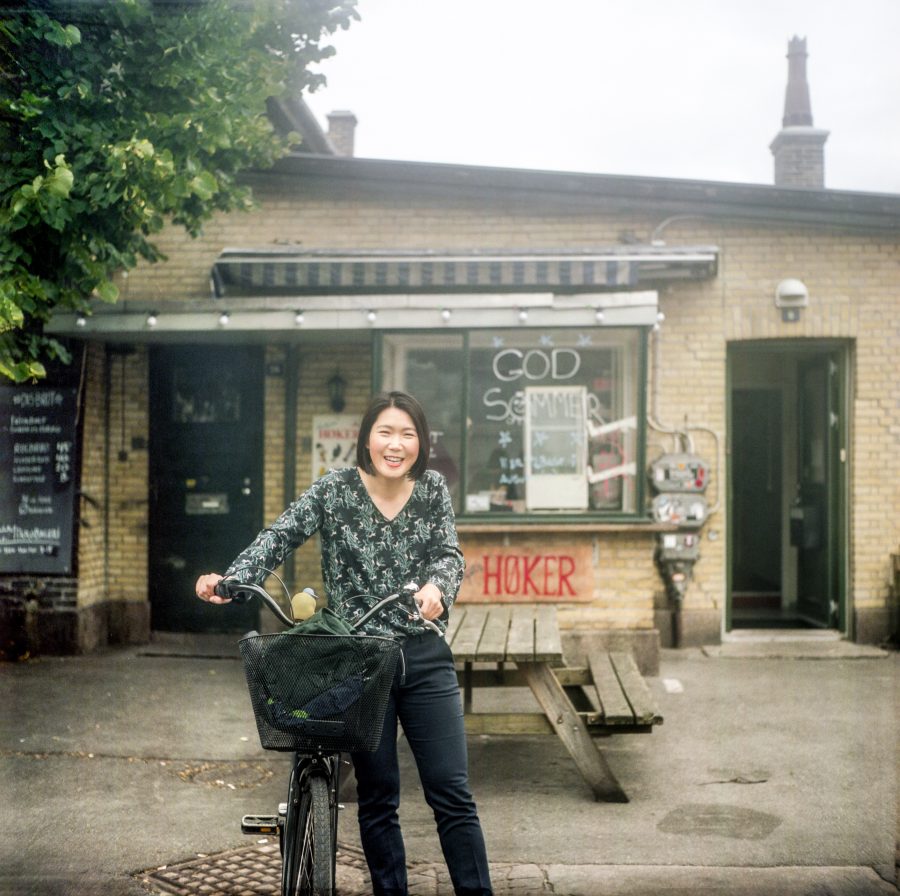
My girlfriend and her bike in Kødbyen, Copenhagen. Shot with the Yashica Mat 124g 80mm f3.5 with Kodak Portra 160 film. Notice that the photo is square because the negative is 6×6, why many Instagram photographers love these kind of cameras. Full size
Other notes
Getting your film developed are normally pretty easy. Most big cities have good professional film labs. Here in Copenhagen there is the lab Laboratoriet i Nannasgade that have good quality service but they close early. I recommend you to go to Photografica (Skindergade 41, Copenhagen), they will give your film to the same lab, that adds an extra delay but you end up paying a bit less (65 Dkk for developing film).
Conclusion
Pros:
- Medium format film cameras have great lenses and you can even use them digitally in many ways. A lot of them are very undervalued right now, might change as digital medium format cameras like the Fujifilm GFX 50 gets more popular.
- It fun to shoot film if you are not used to it, especially the first couple of rolls are a thrill. You need to think more because you don’t have unlimited shoots, that’s a good experience to try.
- Film gear keeps it’s value, buy it, try it, resell it again with small or no loss. So even if you end up disliking film you can always resell.
Cons:
- Film photography is expensive because you will get G.A.S. (Gear Acquisition Syndrome). There’s something satisfying about buying what used to be the most expensive gear only professionals could afford. You will end up spending a lot of money on Ebay, but like mentioned above, you can easily resell it again.
- Old film cameras looks cool and are fun to try but they are a pain in the ass. You will often miss a lot of great shots right in front of your eyes because you had this old school gear and not a modern camera. And for me that is the purpose of photography, capturing the moment.
- High iso film is not the same as high iso digital sensors, not photos you are gonna enjoy on a big monitor only on social media or the web.
- You will very likely have to spend extra money and time on the cameras you buy, because something is broken. It happened again and again to me. Expect it before buying.
- Scanning film to digitalize it is painful and very unsatisfying. It takes a lot of time and you will most likely be disappointed. I had a hard time getting good results, tried different scanners and methods, always got same bad results. I used a Epson V500 but heard you can get better with none flatbed scanners (they are also more expensive though).
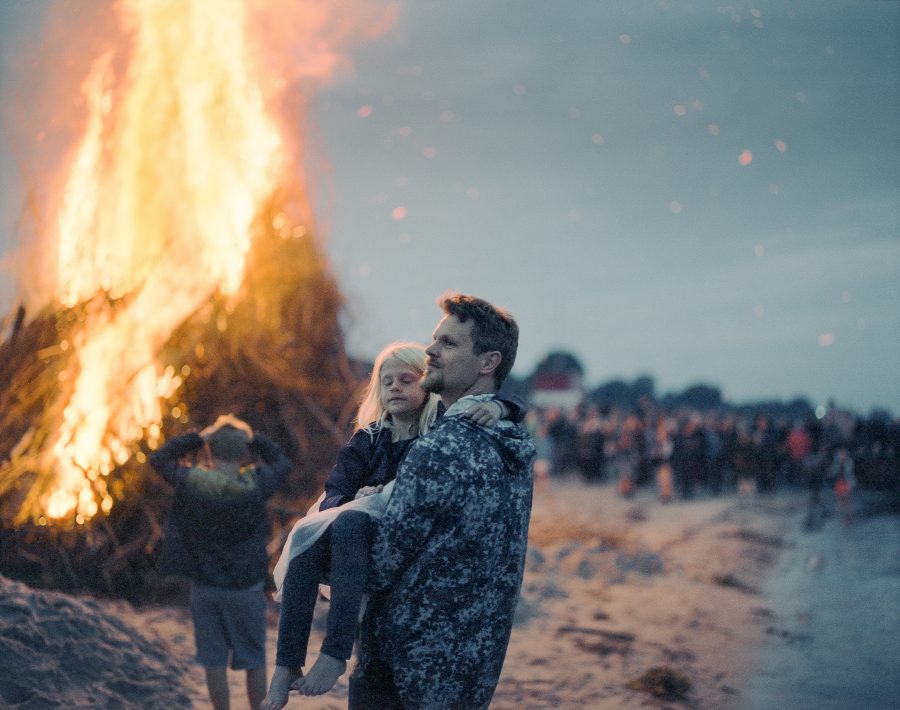
Mid summer event (Sankt Hans) in Denmark. Taken with Pentax 6×7 + 105mm f2.4 with Cinestill 800 film. Full size
Take the things you hear about film with a grain of salt. You often hear about the super high resolution over digital, which I don’t think is true at all. Don’t expect film to be better than digital, only shoot film if you feel you are missing something with digital.
Film do have something special about it though. The way colors render, the way lighting looks different than on digital. And it’s a fun experience you won’t forget.
For someone just starting out in photography I don’t recommend film, but for someone that has tried most things in the digital world, film is a fun experience to try.
Links
If you get into film, check out these:
Ben Horne (youtube channel) – American nature photographer that uses old large format cameras.
The Film Photography Project (podcast) – the ultimate group of film nerds, very enjoyable to listen to.
Nick Carver (youtube) – American dessert photographer, love his videos, wish he would produce some more!
Update: Also read my Shooting Analog Film Part 2 and Shooting Analog Film Part 3.
